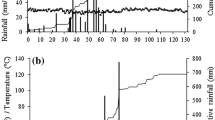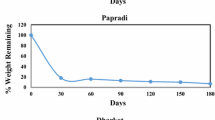Abstract
Tree legumes can serve as nitrogen (N) source for cereals in resource poor farms where chemical fertilizer is financially unaffordable. Despite the increasing importance of Paraserianthes falcataria in tropical agroforestry systems of Southeast Asia, little information is available on the decomposition and N release patterns of P. falcataria. Quality of P. falcataria roots and leaves, as individual components and as a mixture, was determined before incubating in an 15N labeled acidic Ultisol under controlled laboratory conditions. Decomposition was monitored as CO2 evolution and inorganic N released over time. The aim was to determine inorganic soil N and pH dynamics as affected by residue quality. Residue quality assessment based on (Polyphenol + Lignin): N was in the order of P. falcataria leaves > P. falcataria mixture of leaves and roots > P. falcataria roots. The same order was observed for nitrogen and carbon mineralization rate (P <0.05), indicating that mixing of residues of varying quality would provide a means of strategically modifying nutrient release. P. falcataria leaves and the mixture of leaves and roots significantly (P<0.05) mitigated soil acidity while P. falcataria roots alone did not.
Similar content being viewed by others
References
Anderson J.M and Ingram J.S.I. 1993. Tropical Soil Biology and Fertility: A handbook of Methods. CAB International, Wallingford, UK., 221 pp.
Bereck A.K., Radjagukguk B. and Maas A. 1995. The effect of different organic materials on the alleviation of Al toxicity in soyabean on a yellow podozolic soil. In: Dale R.A., Grundon N.J., Rayment G.E. and Probert M.E. (eds), Plant Interactions at Low pH: Principles and Management. Kluwer Academic Publishers, Dordrecht, Netherlands, pp. 579–584.
Birch H.F. 1964. Mineralization of plant nitrogen following alter-nate wet and dry conditions. Plant Soil 20: 43–49.
Briones M.J.I. and Ineson P. 1996. Decomposition of eucalyptus leaves in litter mixtures. Soil Biol. Biochem. 281: 1381–1388.
Bundy L.G. and Bremner J.M. 1972. A simple titrimetric method for the determination of organic carbon in soils. Soil. Sci. Soc. Am. Proc. 36: 273–275.
Handayato E., Cadisch G. and Giller K.E. 1994. Nitrogen release from pruning of regume hedgerow trees in relation to quality of the prunings and incubation method. Plant Soil 160: 237–248.
Haynes R.J. and Mokolobate M.S 2001. Amelioration of Al toxicity and P deficiency in acid soil by additions of organic residues; a critical review of the phenomenon and the mechanisms involved. Nutrient Cycling in Agroecosystems 59: 47–63.
Hood R. 2001. Evaluation of a new approach to the nitrogen 15 isotope dilution technique, to estimate crop N uptake from or-ganic residues in the field. Biol. Fertil. Soils 34: 156–161.
Keeney D.R. and Nelson D.W. 1982. Nitrogen-inorganic forms.. In: Page A.L., Miller R.H. and Keeney D.R. (eds), Methods of Soil Analysis. Part 2. Chemical and Microbiology Properties. 2nd edn. ASA, Madison, Wisconsin, USA, pp. 643–698.
Mafongoya P.L. and Nair P.K.R. 1997. Multipurpose tree prunings as a source of nitrogen to maize under semiarid conditions in Zimbabwe. 1. Nitrogen recovery in relation to pruning quality and method of application. Agrofor. Syst. 35: 31–46.
Mafongoya P.L., Nair P.K.R. and Dzowela B.H. 1998. Mineralization of nitrogen from decomposing leaves of multipurpose trees as affected by their chemical composition. Biol. Fertil. Soils 27: 143–148.
Noble A.D., Zenneck I. and Randall P.J. 1996. Leaf litter ash alkalinity and neutralization of soil acidity. Plant Soil 179: 293–302.
Palm C.A. 1995. Contribution of agroforestry trees to nutrient requirements of intercropped plants. Agrofor. Syst. 30: 105–124.
Palm C.A., Myers R.J.K. and Nandwa S.M. 1997. Combined use of organic and inorganic nutrient sources for soil fertility maintenance and replenishment.. In: Buresh R.J, Sanchez P.A. and Calhoun F. (eds), Replenishing Soil Fertility in Africa. SSSA Madison, Wisconsin, USA, pp. 193–217.
Prasad R. and Power J.T. 1997. Soil Fertility Management for Sustainable Agriculture. CRC press LLC, New York, New York, USA, pp. 67–92.
Sanchez P.A. and Logan T.J. 1992. Myths and science about the chemistry and fertility of soils in the tropics.. In: Lal R. and Sanchez P.A. (eds), Myths and Science of Soils of the Tropics. SSSA Madison, Wisconsin, USA, pp. 35–46.
Smith J.L., Paperndick R.I., Bezdicek D.F. and Lynch J.M. 1993. Soil organic matter dynamics and crop residue management.. In: Blaine M.F (ed.), Soil Microbial Ecology: Application in Agri-cultural and Environmental Management. Marcel Decker, New York, New York, USA, pp. 65–94.
Smucker A.J.M., Ellis B.G. and Kang B.T. 1995. Root, nutrient, and water dynamics in alley cropping on an Alfisol in a forest savanna transition zone. In: Kang B.T., Larbi A. and Osiname A.O. (eds), Alley Farming Research and Development. IITA, Ibadan, Nigeria, pp. 103–121.
Swift M.J., Kang B.T., Mulongoy K. and Woomer P. 1991. Organic-matter management for sustainable soil fertility in tropical cropping systems. In: Dumanski J., Pushparajah E., Lanthan M. and Myers R. (eds), Evaluation for Sustainable Land Management in the Developing World 2, Technical papers proceeding No. 12(2). IBSRAM, Bangkok, Thailand, pp. 306–326.
Van Antwerpen R. and Meyer J.H. 1999. Soil degradation II. Effect of trash and inorganic fertilizer application on soil strength. Proc. S. Afri. Sug. Technol. Ass. 73: 14–20.
Wan Rasidah K., Van Cleemput O. and Zaharah A.R. 2001. Microbial respiration and nitrogen release patterns of decomposing Acacia mangium leaf litter from Kemasul Reserve, Malaysia. J. Trop. For. Sci. 13(11): 1–12.
Wong M.T.F., Nortcliff S. and Swift R.S. 1998. Method for determining the acid amelioration capacity of plant residue compost, urban waste, farm-yard manure and peat applied to tropical soils. Commun. Soil Sci. Plant Anal. 29: 2927–2937.
Zaharah A.R., Bah A.R., Mwange N.K., Kathuli P. and Juma P. 1999. Management of Gliricidia (Gliricidia sepium) residues for improved sweet corn yield in an Ultisol. Nutrient Cycling in Agroecosystems 54: 31–39.
Author information
Authors and Affiliations
Rights and permissions
About this article
Cite this article
Chintu, R., Zaharah, A. & Wan Rasidah, A. Decomposition and nitrogen release patterns of Paraserianthes falcataria tree residues under controlled incubation. Agroforest Syst 63, 45–52 (2004). https://doi.org/10.1023/B:AGFO.0000049432.65094.48
Issue Date:
DOI: https://doi.org/10.1023/B:AGFO.0000049432.65094.48




